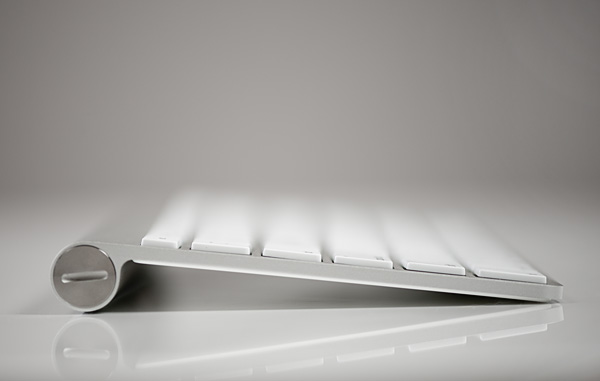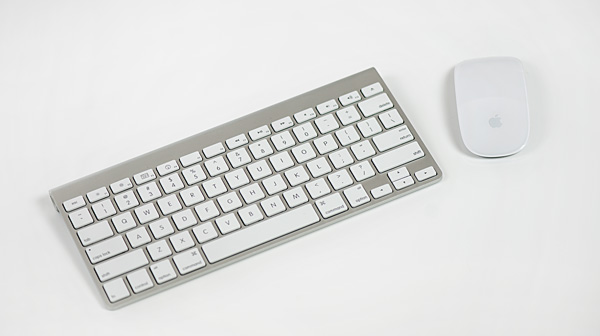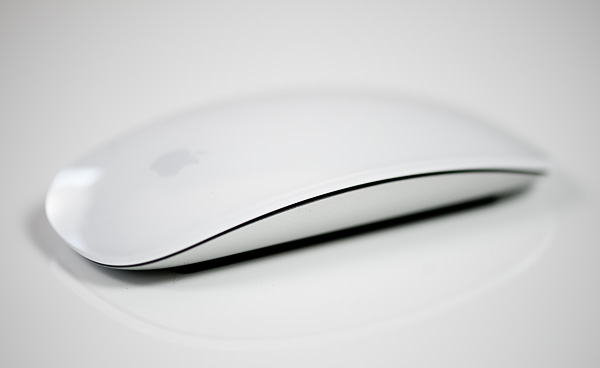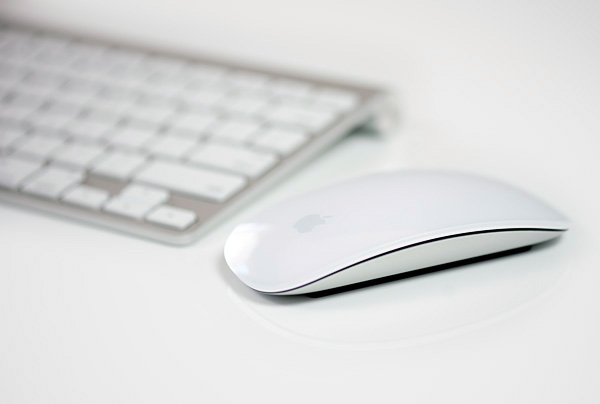The 27-inch Apple iMac Review (2011)
by Anand Lal Shimpi on May 27, 2011 2:30 AM ESTThe Peripherals
I've never been a fan of wireless peripherals - I didn't want more things to charge. Last year I finally broke down and bought a wireless mouse: Microsoft's Wireless Mobile Mouse 4000. I didn't buy it for mobility, I just liked the form factor.
The iMac comes with all wireless peripherals. In fact, if you stick with WiFi for network access, there's only a single cable you need going to the iMac: power. By default you get Apple's Wireless Keyboard and a Magic Mouse.
The Wireless Keyboard is a Bluetooth keyboard that runs off of two AA batteries. It pairs effortlessly with the iMac and I didn't encounter any issues with interference in using it. The keyboard seems to burn through batteries quicker than the mouse, perhaps that's because I type far too much or there's an issue with power management under OS X. After a week of use I'm down to 81% on a fresh pair of batteries (this is my second set).
The keyboard itself is a lot like Apple's standard aluminum keyboard, just wireless and more compact. Apple chopped off the dedicated home/end key island as well as the numeric keypad. Under OS X Cmd + Left/Right Arrow take the place of Home/End for me so part of the sacrifice isn't a problem, but the missing numeric keypad is. I do entirely too much data entry (ahem, benchmarks) to not have a dedicated numeric keypad, and for some reason Apple doesn't offer the Wireless Keyboard with one.
If you don't type tons of numbers every day however, the Wireless Keyboard is really nice. Apple had to stick a function key to the left of the control key, which is a bit bothersome (leave my control/option/cmd row alone) but it's nothing you can't get used to. The footprint is great. I have a giant desk, but I always seem to run out of desk space. The Wireless Keyboard makes it so that I can reclaim a small amount of high value desk area.
Typing feel and keyboard angle are both great - no complaints there. I'm a fan of Apple's keyboards.
Pointing devices designed in Cupertino are another story entirely. I've never liked Apple's mice. It was a big enough problem that when I first tried my Month with a Mac experience I ditched Apple's mouse. There was no way I was going to give the platform a fair shake if I had to use that thing. Since then Apple has at least enabled double clicking - the surface of the Magic Mouse is touch sensitive, click with your right finger and you get a right click. The Magic Mouse has no scroll wheel but drag your finger around on its surface and you get the best scrolling experience on a physical mouse.
The Magic Mouse is also a Bluetooth device that quickly pairs with the iMac. I noticed under Windows there's always a second or two of lag before it recognizes the mouse whereas it's useable as soon as you can see it under OS X.
My complaints about the Magic Mouse are three-fold. As I've mentioned before, the Magic Mouse doesn't have soft rubber feet that glide around on your desk. Instead you get two hard plastic strips that just seem to scrape against all surfaces. Tracking isn't a problem, but it's not a pleasant experience.
The other issue I have is the form factor itself. Microsoft's Wireless Mobile Mouse 4000 is small but it has a nice curve to it that seems to match my hand very well. The Magic Mouse on the other hand doesn't conform to any part of my body. I can lay my hand flat on it but either I'm not conditioned to do that or that's not a very comfortable way to use the mouse for long periods of a time.
Finally there's the clicking noise it makes. Modern mice seem to have a solid but more muted click, whereas the sharp click of the Magic Mouse reminds me of the past decade of Apple mice. I assume that's what Apple was going for, but Apple's market share has grown considerably in the past 10 years - it's ok to let go of some traditions.
Apple does offer the Magic Trackpad as a no-cost option. I have a love/hate relationship with the Magic Trackpad as a pointing device. Scrolling and gestures are great on it, but I prefer a normal mouse for most everything else.
















139 Comments
View All Comments
Mentawl - Friday, May 27, 2011 - link
Hrm, I wouldn't call that backwards at all. The monitor is perhaps the single most important thing when interfacing with a computer, and it's worth splashing out on it over 10% extra CPU or GPU power or whatnot.mcnabney - Friday, May 27, 2011 - link
You missed the point. Definitely pay good money for a nice screen.However, in three years this nice screen on the iMac is going to be stuck on an outdated system. If you bought the system separate from the monitor you could save a huge cost (of having to buy ANOTHER expensive IPS screen) when upgrading to a new system.
Is is actually kind of sad, knowing that all of these awesome screens are going to land in the junk heap in five years when they could provide excellent service for 10-20 years.
KoolAidMan1 - Friday, May 27, 2011 - link
The plus side is that iMac resale value is very high, and they update the displays every 2-3 years or so. Sell the old iMac on ebay for a good amount, and use the proceed to replace it with a new one with a better LCD.I upgrade my gaming PCs every 2-3 years, and I wish that upgrading it was as simple as with my iMac. With the iMac I put the whole thing in the box it came in, and the new one is faster with a better monitor. With my PC I have to sell components piecemeal for way less return than I get with my Mac stuff.
rubaiyat - Wednesday, September 7, 2011 - link
So what do you do with your old PCs throw them away when you recycle the peripherals, and selected components? Not that there is much point to most of those.Macs go to a new home and the money from that pays a large part of a newer Mac.
PC upgrade = 1 half new PC, plus box of discarded parts.
Mac upgrade = 2 computers, 1 totally new, 1 older but still working.
So which makes more sense? Which is more environmentally sensible?
kevith - Friday, May 27, 2011 - link
I think it´s a bit like buying a stereo: Use half your cash on the speakers, and the other jalf on amp, CD-player and good cables.Then you have a well-matched system.
And here it makes sense - to me at least - to spend one half on the screen.
You´re gonna look at it several hours every day, and it´l probably outlive two or three builds ahead.
Spivonious - Friday, May 27, 2011 - link
I think you should spend 80% on speakers, 20% on other stuff (and no more than $10 on cables. Really, they don't make a difference). Most amps today are equally good, and jumping from 100W per channel to 150W per channel is pointless when a normal music source will use 1-2W per channel. Even really blasting it will only use 5-10W. I'd much rather get better sound, and that comes with better speakers.mcnabney - Friday, May 27, 2011 - link
Yep.My speakers ~2k
Receiver ~400
BluRay ~120
Cables ~50 for everything (12ga for speakers, 1 nice RCA for sub, the rest is cheap digital)
Exodite - Friday, May 27, 2011 - link
Regarding the display resolution it's all in what you do.I mostly work with text and horizontal space is pretty meaningless for me, which means the only upgrade for my two 1280x1024 displays is to go for a 2560x1440 or 2560x1600 panel.
There's no way in hell I'm paying the asking price for those though, I can get no less than *eight* 1080p displays for the price of one 27" 2560x1440 display. Mostly, I suspect, due to these kind of displays being aimed at graphics professionals and coming with all kinds of features that I care nothing about.
I can only agree with Anand and hope that the strong focus on high-DPI mobile displays will trickle upwards too. After all, with 4" panels doing 720P and 10" displays doing quadruple that a 23-27" high-resolution display shouldn't be a problem.. right?
Rinadien - Friday, May 27, 2011 - link
Or... you could get a 1900x1200 display, and rotate it 90 degrees?KoolAidMan1 - Friday, May 27, 2011 - link
Those eight 1080p displays are TN. Sorry, not interested in downgrading, I'd rather have one high quality display instead of eight crappy ones. I have two IPS displays on my desk and I wouldn't trade them for any number of TN monitors.